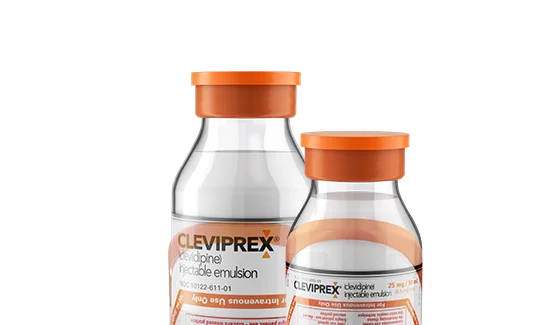CLEVIPREX® (clevidipine) Frequently asked questions

CLEVIPREX Efficacy & Pharmacology
Open all
What were the results of clinical trials of CLEVIPREX?
CLEVIPREX efficacy was evaluated in 4 clinical trials:
- ESCAPE-1: Preoperative hypertension
- ESCAPE-2: Postoperative hypertension
- VELOCITY: Acute severe hypertension
- ACCELERATE: Intracerebral hemorrhage
CLEVIPREX was also studied against active comparators in 3 parallel, prospective, open-label studies (ECLIPSE). The ECLIPSE safety studies included patients undergoing cardiac surgery (N=1506) who were randomized to receive either CLEVIPREX or nicardipine, nitroglycerin, or sodium nitroprusside.1 Learn more about the results of the ECLIPSE trials..
Is CLEVIPREX an alternative to other calcium channel blockers?
Yes, CLEVIPREX is an intravenously administered dihydropyridine calcium channel blocker indicated for the reduction of BP when oral therapy is not feasible or not desirable.2
What is the onset and offset of CLEVIPREX?
CLEVIPREX begins to reduce SBP within 2 minutes of initiation dose. In most patients, full recovery of BP is achieved 5-15 minutes after the infusion is stopped.2
CLEVIPREX Safety Profile
What are the most common side effects of CLEVIPREX?
In clinical trials, the most adverse reactions (>2%) with CLEVIPREX were headache, nausea, and vomiting.2
CLEVIPREX Dosing
How do you dose CLEVIPREX?
CLEVIPREX provides low-volume, non–weight-based, titratable dosing (dose may be doubled every 90 seconds initially). It is metabolized by esterases in the blood and extravascular tissues, so elimination is unlikely to be affected by hepatic or renal dysfunction.2 Learn more about how to dose and administer CLEVIPREX.
CLEVIPREX Guidelines
Is CLEVIPREX recommended by AIS guidelines?
Since 2018, the Guidelines for the Early Management of Patients With Acute Ischemic Stroke (AIS) have recommended CLEVIPREX as an option for lowering arterial hypertension before, during, and after acute reperfusion therapy.4*
CLEVIPREX is not indicated for the prevention or treatment of stroke.
References: 1. Aronson S, Dyke CM, Stierer KA, et al. The ECLIPSE trials: comparative studies of clevidipine to nitroglycerin, sodium nitroprusside, and nicardipine for acute hypertension treatment in cardiac surgery patients. Anesth Analg. 2008;107(4):1110-1121. 2. CLEVIPREX® (clevidipine) Prescribing Information. 2021. 3. Pollack CV, Varon J, Garrison NA, Ebrahimi R, Dunbar L, Peacock WF. Clevidipine, an intravenous dihydropyridine calcium channel blocker, is safe and effective for the treatment of patients with acute severe hypertension. Ann Emerg Med. 2009;53(3):329-338. 4. Powers WJ, Rabinstein AA, Ackerson T, et al; American Heart Association Stroke Council. 2018 Guidelines for the Early Management of Patients with Acute Ischemic Stroke: a guideline for healthcare professionals from the American Heart Association/American Stroke Association. Stroke. 2018;49(3):e46-e110. 5. Greenberg SM, Ziai WC, Cordonnier C, et al; American Heart Association/American Stroke Association. 2022 guideline for the management of patients with spontaneous intracerebral hemorrhage: a guideline from the American Heart Association/American Stroke Association. Stroke. 2022;53(7):e282-e361.
Open
Close
The information provided in this website is intended for US healthcare professionals only.
I certify that I am a US healthcare professional.